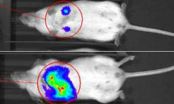(Press-News.org) Breast cancer cells can lay the groundwork for their own spread throughout the body by coaxing cells within lymphatic vessels to send out tumor-welcoming signals, according to a new report by Johns Hopkins scientists.
Writing in the Sept. 2 issue of Nature Communications, the researchers describe animal and cell-culture experiments that show increased levels of so-called signaling molecules released by breast cancer cells. These molecules cause lymphatic endothelial cells (LECs) in the lungs and lymph nodes to produce proteins called CCL5 and VEGF. CCL5 attracts tumor cells to the lungs and lymph nodes, and VEGF increases the number of blood vessels and makes them more porous, allowing tumor cells to metastasize and infiltrate the lungs.
In the same report, the researchers say maraviroc, a drug already approved for treating HIV infection, blocked the siren call of CCL5 in tests on animals and cells and prevented tumor spread (metastasis). Additional experiments using a combination of maraviroc and a drug that blocks the VEGF protein suggest that the treatment duo could be an effective way to prevent metastatic disease in human breast cancer patients, according to the researchers.
Because the anti-retroviral drug maraviroc has already been approved by the U.S. Food and Drug Administration and has been shown safe for long term, oral use, it could be tested in clinical trials sooner rather than later, says Aleksander Popel, Ph.D., a professor in the Department of Biomedical Engineering at the Johns Hopkins University School of Medicine and member of the Johns Hopkins Kimmel Cancer Center.
"It was surprising to find that LECs can play such an active and significant role in tumor spread." Popel noted. "Conventionally, lymphatic vessels are regarded mainly as passive conduits through which tumor cells spread from the primary tumor and eventually metastasize," he said. "However, we now know that lymphatic vessels enable metastasis, and other studies also show that they play an important role in whether or not immune cells recognize and attack cancer cells."
Popel and colleagues traced the influence of tumor signaling on LECs in cell cultures and in mice. Breast cancer cells were bathed in a nutrient-rich liquid, and, as the cancer cells grew, the investigators detected secretions of a signaling molecule called interleukin-6 (IL6) in the liquid.
Mice that were injected with the IL6-containing liquid experienced a continual rise in CCL5 levels in blood samples for several weeks. Nine of 10 tumor-bearing mice injected with the IL6-laden liquid developed metastases five weeks later. Only two of 10 mice, exposed to the liquid and given a combination of maraviroc and a VEGF-blocking drug, developed metastases.
Because maraviroc blocks the actions of CCL5, it could be delivered, along with standard chemotherapy, right after surgically removing a tumor in a bid to prevent any leftover circulating tumor cells from finding a new metastatic niche in the body, Popel says.
"However, IL6-secreting tumors could be laying the groundwork for metastasis much earlier than surgery occurs in a patient," he said. "To prevent metastatic sites from taking root, we could administer drugs that block IL6 before surgery."
The study did not address when or how to remove lymph node tissue surgically, as is often done as part of breast cancer treatment, but Popel and colleagues hope to explore the issue in future studies.
INFORMATION:
Other researchers on the paper include Esak Lee, the first author, and Niranjan Pandey of the Department of Biomedical Engineering, Johns Hopkins University School of Medicine and Elana Fertig, Kideok Jin, and Saraswati Sukumar of the Johns Hopkins Kimmel Cancer Center.
Funding for the study was provided by the National Institutes of Health's National Cancer Institute (R01 CA138264) and the Safeway Foundation for Breast Cancer.
Johns Hopkins Medicine (JHM), headquartered in Baltimore, Maryland, is a $7 billion integrated global health enterprise and one of the leading academic health care systems in the United States. JHM unites physicians and scientists of the Johns Hopkins University School of Medicine with the organizations, health professionals and facilities of The Johns Hopkins Hospital and Health System. JHM's vision, "Together, we will deliver the promise of medicine," is supported by its mission to improve the health of the community and the world by setting the standard of excellence in medical education, research and clinical care. Diverse and inclusive, JHM educates medical students, scientists, health care professionals and the public; conducts biomedical research; and provides patient-centered medicine to prevent, diagnose and treat human illness. JHM operates six academic and community hospitals, four suburban health care and surgery centers, and more than 35 Johns Hopkins Community Physicians sites. The Johns Hopkins Hospital, opened in 1889, has been ranked number one in the nation by U.S. News & World Report for 22 years of the survey's 25 year history, most recently in 2013. For more information about Johns Hopkins Medicine, its research, education and clinical programs, and for the latest health, science and research news, visit http://www.hopkinsmedicine.org
Media Contacts:
Vanessa Wasta, 410-614-2916, wasta@jhmi.edu
Amy Mone, 410-614-2915, amone@jhmi.edu
‘Prepped’ by tumor cells, lymphatic cells encourage breast cancer cells to spread
HIV drug plus blood vessel growth-blockers could halt metastasis
2014-09-02
ELSE PRESS RELEASES FROM THIS DATE:
Cool calculations for cold atoms
2014-09-02
Chemical reactions drive the mechanisms of life as well as a million other natural processes on earth. These reactions occur at a wide spectrum of temperatures, from those prevailing at the chilly polar icecaps to those at work churning near the earth's core. At nanokelvin temperatures, by contrast, nothing was supposed to happen. Chemistry was expected to freeze up. Experiments and theoretical work have now show that this is not true. Even at conditions close to absolute zero atoms can interact and manage to form chemical bonds.
Within this science of ultracold ...
Enzyme controlling metastasis of breast cancer identified
2014-09-02
Researchers at the University of California, San Diego School of Medicine have identified an enzyme that controls the spread of breast cancer. The findings, reported in the current issue of PNAS, offer hope for the leading cause of breast cancer mortality worldwide. An estimated 40,000 women in America will die of breast cancer in 2014, according to the American Cancer Society.
"The take-home message of the study is that we have found a way to target breast cancer metastasis through a pathway regulated by an enzyme," said lead author Xuefeng Wu, PhD, a postdoctoral researcher ...
Study links sex hormone levels in the blood to risk of sudden cardiac arrest
2014-09-02
LOS ANGELES (Sept. 2, 2014) – Measuring the levels of sex hormones in patients' blood may identify patients likely to suffer a sudden cardiac arrest, a heart rhythm disorder that is fatal in 95 percent of patients.
A new study, published online by the peer-reviewed journal Heart Rhythm, shows that lower levels of testosterone, the predominant male sex hormone, were found in men who had a sudden cardiac arrest. Higher levels of estradiol, the major female sex hormone, were strongly associated with greater chances of having a sudden cardiac arrest in both men and women. ...
UO-Berkeley Lab unveil new nano-sized synthetic scaffolding technique
2014-09-02
EUGENE, Ore. -- Scientists, including University of Oregon chemist Geraldine Richmond, have tapped oil and water to create scaffolds of self-assembling, synthetic proteins called peptoid nanosheets that mimic complex biological mechanisms and processes.
The accomplishment -- detailed this week in a paper placed online ahead of print by the Proceedings of the National Academy of Sciences -- is expected to fuel an alternative design of the two-dimensional peptoid nanosheets that can be used in a broad range of applications. Among them could be improved chemical sensors ...
Microphysiological systems will revolutionize experimental biology and medicine
2014-09-02
The Annual Thematic issue of Experimental Biology and Medicine that appears in September 2014 is devoted to "The biology and medicine of microphysiological systems" and describes the work of scientists participating in the Microphysiological Systems Program directed by the National Center for Advancing Translational Sciences (NCATS) of the National Institutes of Health (NIH) and funded in part by the NIH Common Fund. The Defense Advanced Research Projects Agency (DARPA) and the Food and Drug Administration (FDA) are collaborating with the NIH in the program. Fourteen of ...
An uphill climb for mountain species?
2014-09-02
A recently published paper provides a history of scientific research on mountain ecosystems, looks at the issues threatening wildlife in these systems, and sets an agenda for biodiversity conservation throughout the world's mountain regions.
The paper, "Mountain gloom and mountain glory revisited: A survey of conservation, connectivity, and climate change in mountain regions," appears online in the Journal of Mountain Ecology. Authors are Charles C. Chester of Tufts University, Jodi A. Hilty of the Wildlife Conservation Society, and Lawrence S. Hamilton of World Commission ...
Sabotage as therapy: Aiming lupus antibodies at vulnerable cancer cells
2014-09-02
New Haven, Conn. — Yale Cancer Center researchers may have discovered a new way of harnessing lupus antibodies to sabotage cancer cells made vulnerable by deficient DNA repair.
The findings were published recently in Nature's journal Scientific Reports.
The study, led by James E. Hansen, M.D., assistant professor of therapeutic radiology at Yale School of Medicine, found that cancer cells with deficient DNA repair mechanisms (or the inability to repair their own genetic damage) were significantly more vulnerable to attack by lupus antibodies.
"Patients with lupus ...
Seatbelt laws encourage obese drivers to buckle up
2014-09-02
CHAMPAIGN, Ill. — Obesity is associated with many health risks, including heart disease and diabetes, but University of Illinois researchers have found a possible way to mitigate one often-overlooked risk: not buckling up in the car.
A new study led by Sheldon H. Jacobson, a professor of computer science and of mathematics, found that increasing the obesity rates are associated with a decrease in seatbelt usage. However, these effects can be mitigated when seatbelt laws are in effect.
"Primary seatbelt laws lead to increased use of seatbelts," Jacobson said. "On the ...
Melatonin does not reduce delirium in elderly patients having acute hip surgery
2014-09-02
Melatonin supplements do not appear to lessen delirium in elderly people undergoing surgery for hip fractures, indicates a new trial published in CMAJ (Canadian Medical Association Journal)
Many older patients in hospital experience delirium, with disturbances in their sleep–wake cycle. Antipsychotic medications used to reduce symptoms have serious adverse effects, leading the US Food and Drug Administration to warn against their use. Benzodiazepines are also used, although they are known to cause or aggravate delirium. A lack of melatonin may be one factor underlying ...
Changing microbial dynamics in the wake of the Macondo blowout
2014-09-02
In an article in the September issue of BioScience, Samantha Joye and colleagues describe Gulf of Mexico microbial communities in the aftermath of the 2010 Macondo blowout. The authors describe revealing population-level responses of hydrocarbon-degrading microbes to the unprecedented deepwater oil plume.
The spill provided a unique opportunity to study the responses of indigenous microbial communities to a substantial injection of hydrocarbons. Surveys of genetic identifiers within cells known as ribosomal RNA and analyses relying on modern techniques including metagenomics, ...
LAST 30 PRESS RELEASES:
Plant hormone allows lifelong control of proteins in living animal for first time
Swedish freshwater bacteria give new insights into bacterial evolution
Global measures consistently underestimate food insecurity; one in five who suffer from hunger may go uncounted
Hidden patterns of isolation and segregation found in all American cities
FDA drug trials exclude a widening slice of Americans
Sea reptile’s tooth shows that mosasaurs could live in freshwater
Pure bred: New stem cell medium only has canine components
Largest study of its kind highlights benefits – and risks – of plant-based diets in children
Synergistic effects of single-crystal HfB2 nanorods: Simultaneous enhancement of mechanical properties and ablation resistance
Mysterious X-ray variability of the strongly magnetized neutron star NGC 7793 P13
The key to increasing patients’ advance care medical planning may be automatic patient outreach
Palaeontology: Ancient tooth suggests ocean predator could hunt in rivers
Polar bears may be adapting to survive warmer climates, says study
Canadian wildfire smoke worsened pediatric asthma in US Northeast: UVM study
New UBCO research challenges traditional teen suicide prevention models
Diversity language in US medical research agency grants declined 25% since 2024
Concern over growing use of AI chatbots to stave off loneliness
Biomedical authors often call a reference “recent” — even when it is decades old, analysis shows
The Lancet: New single dose oral treatment for gonorrhoea effectively combats drug-resistant infections, trial finds
Proton therapy shows survival benefit in Phase III trial for patients with head and neck cancers
Blood test reveals prognosis after cardiac arrest
UBCO study finds microdosing can temporarily improve mood, creativity
An ECOG-ACRIN imaging study solves a long-standing gap in metastatic breast cancer research and care: accurately measuring treatment response in patients with bone metastases
Cleveland Clinic presents final results of phase 1 clinical trial of preventive breast cancer vaccine study
Nationally renowned anesthesiology physician-scientist and clinical operations leader David Mintz, MD, PhD, named Chair of the Department of Anesthesiology at the UM School of Medicine
Clean water access improves child health in Mozambique, study shows
Study implicates enzyme in neurodegenerative conditions
Tufts professor named Fellow of the National Academy of Inventors
Tiny new device could enable giant future quantum computers
Tracing a path through photosynthesis to food security
[Press-News.org] ‘Prepped’ by tumor cells, lymphatic cells encourage breast cancer cells to spreadHIV drug plus blood vessel growth-blockers could halt metastasis



